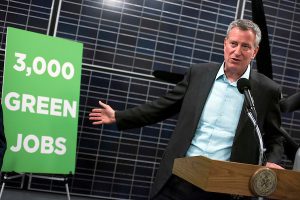June 2, 2017
By Nancy Anderson, Ph.D.
With a tip of the hat to Jane Austen, let me tweak her famous observation “It is a truth universally acknowledged, that a single man in possession of a good fortune, must be in want of a wife.” Today, “It is a truth universally acknowledged that a liberal big city Mayor must be in want of good jobs for all.” I can’t vouch that Austen was comedy-free, but I do believe that Mayor de Blasio is earnest in his commitment to good jobs for all as part of his OneNYC mission.

Photo: Ed Reed Mayor de Blasio announces GJC
In the Mayor’s 2017
OneNYC Progress Report, large print trumpets his credo laid out in the first
OneNYC Report of 2015: “I believe fundamentally you can’t have environmental sustainability without economic sustainability. Nor can you have economic sustainability without environmental sustainability.” This is a good thing to believe, so let’s see how this credo is getting expressed in concrete policy and actions.
(more…)
June 1, 2013

As a part of our Spring 2013
SustaiNYC tours, architect Chris Benedict of Chris Benedict, R.A. showed the GreenHomeNYC community her latest project– a 24-unit apartment building in Bushwick that is designed to meet Passive House standards. Passive Houses are airtight buildings that are designed and built under rigorous conversion standards to dramatically minimize energy use. Thoughtful building design and infrastructure are at the core of a Passive House, so it was a treat to tour the building mid-construction and explore the details firsthand.

Chris and her team have designed 424 Melrose Street to be as airtight as possible, using modeling software such as PHPP (Passive House Planning Package) to calculate energy balance and facilitate building decisions. Each part of the building– including the walls, floors, windows, and the roof– are expertly designed with selected materials to maximize insulation. While optimizing solar energy and heat from appliances and occupants within the building, the team is also working to reduce the size of heating and AC systems.
(more…)
April 7, 2011
Tom Sahagian is the director of the Energy Division at Power Concepts, a consulting engineering firm based in Manhattan. During his three decades in energy efficiency Tom has worked with every technology from solar and wind to condensing boilers and cogeneration. He teaches and writes widely, and recently served on Mayor Bloomberg’s Green Codes Task Force.
February 4, 2009
Chris Benedict is an architect in New York City. Her firm, Chris Benedict, R.A. specializes in the design of energy efficient, durable, healthy housing projects that are built for the same price as typical construction.
Chris has rehabilitated eighty-one apartment buildings in New York City. Eighteen of these buildings were the first sustainable and energy efficient gut rehabilitation projects in New York City (1997). The project was awarded Environmental Project of the Year by The New York Chapter of The Association of Energy Engineers (AEE) and Chris was awarded Environmental Professional of the Year in 1999 by AEE International. Chris’ ground breaking strategies for gut rehabilitation in New York City have become the basis for The City of New York’s new guidelines for construction. Four new construction residential buildings with 104 apartments designed by Chris are complete. These new buildings each use 15% of the energy of a typical building of the same size for heat and hot water, and 50% of the electricity but cost the same to build as typical residential buildings.
Brian Cheigh is currently managing an ARRA-funded, 1000+ unit Weatherization Assistance Program as the Community Weatherization Partners Program Coordinator at Enterprise Community Partners. He was previously a Senior Project Manager at the New York City Department of Housing Preservation & Development, and more recenlty, the Deputy Director for Housing Development at St. Nicholas Neighborhood Preservation Corporation in Brooklyn. While at St. Nicholas, Brian and his team have focused their efforts to ensure the long-term affordability and sustainability of St. Nicholas’ rental housing portfolio through the sale of Inclusionary Housing Benefits and implementation of energy efficient retrofits.
Brian holds a Masters Degree in City Planning from the Massachusetts Institute of Technology, where he was awarded the Graduate Student Community Service Award from his Department for his work with the greater Boston community. He wrote his master’s thesis on the economic revitalization impacts of Dominican entrepreneurs in Lawrence, Massachusetts, a small post-industrial just northwest of Boston. Prior to becoming a City Planner, Brian worked for South Brooklyn Legal Services as a paralegal representing low-income households in Brooklyn on tax controversy disputes and providing know-your-rightsworkshops in immigrant communities all over the City.
Brian serves on the board of
Community Tax Aid, a non-profit that has been preparing tax returns at no cost for low-income taxpayers since 1969.
Evangeline Dennie, LEED AP is an architectural designer, green building consultant, and founder of EDennie Design for Sustainability. Her most notable design work includes the Tribute Center, which serves as an interim memorial and educational center at Ground Zero (BKSK), and Oulu Bar and Ecolounge in Williamsburg, Brooklyn. Since 2003, Evangeline managed the green building process and facilitated workshops for dozens of educational and commercial projects, as well as co-authored high performance building guidelines with Hillary Brown, AIA, and lead the green consulting team for the first LEED for Existing Buildings high-rise in New York for Random House Bertelsman. She practices, and will soon start teaching green building design by providing workshops from her design studio in Williamsburg, Brooklyn. For more info, email: office AT edennie.com
Tony Daniels is principal of Cycle Architecture, a full service architecture and green building practice in New York. His career has focused on buildings and projects known for their outstanding environmental performance and design excellence. He has served clients including single individuals and large government agencies, ranging from very large to very small. A graduate of Columbia College, he resides in Brooklyn with his wife and two sons.
Architect
Mark Helder is completing ‘439 Metropolitan Green’, his first project as both designer and developer. The building is a high-performance LEED registered building located in Williamsburg, Brooklyn. Mark is committed to bringing highly energy-efficient, environmentally responsible design to the high-end as well as the lower income and affordable housing sector. Mark’s past projects include private homes, not-for-profit spaces, multi-family complexes, and commercial spaces. Mark Helder expanded his studio, Helder Design, from the Netherlands to New York in 2002. The work of Helder Design has been exhibited in the Chicago Architecture Foundation, the South-Eastern Center for Contemporary Design in South Carolina, Gallery 312 in Chicago, and the AIA Center for Architecture in New York City.
Architect
Matthew Skjonsberg works as a project leader for West 8, a leading international office for urban design and landscape architecture, founded by Adriaan Geuze in 1987. A native of the state of Wisconsin, and of the first generation in his family not to farm, Matthew built projects in the private and public sectors in WI, MN, MI and NM prior to joining West 8. He has been a faculty member teaching architecture at Taliesin, the Frank Lloyd Wright School of Architecture, Lawrence University, University of Wisconsin-Stout Polytechnic, and has given lectures and expert workshops at numerous institutions, including the ETH in Zurich, the Berlage Institute in Rotterdam, Parsons in New York, and Harvard GSD in Cambridge. He has participated in diverse symposia, and in 2008 his work ‘Performative Corridors’ (Addis Ababa, Ethiopia) was featured in the Swiss Pavilion at the 2008 Venice Biennale, ‘Out There: Architecture Beyond Building’.
Jeff Perlman is the President of
Bright Power, an energy consultancy. Before founding Bright power, he co-authored (with Greg Kats at Capital E) “The Costs and Financial Benefits of Green Buildings”, a ground-breaking report used economic cost/benefit analysis to show that building healthy, energy-efficient, and environmentally responsible buildings make economic sense, too. He has a degree in Applied Physics from Yale University, and believes that buildings that do well are buildings that benchmark.
 As a part of our Spring 2013 SustaiNYC tours, architect Chris Benedict of Chris Benedict, R.A. showed the GreenHomeNYC community her latest project– a 24-unit apartment building in Bushwick that is designed to meet Passive House standards. Passive Houses are airtight buildings that are designed and built under rigorous conversion standards to dramatically minimize energy use. Thoughtful building design and infrastructure are at the core of a Passive House, so it was a treat to tour the building mid-construction and explore the details firsthand.
As a part of our Spring 2013 SustaiNYC tours, architect Chris Benedict of Chris Benedict, R.A. showed the GreenHomeNYC community her latest project– a 24-unit apartment building in Bushwick that is designed to meet Passive House standards. Passive Houses are airtight buildings that are designed and built under rigorous conversion standards to dramatically minimize energy use. Thoughtful building design and infrastructure are at the core of a Passive House, so it was a treat to tour the building mid-construction and explore the details firsthand.
 Chris and her team have designed 424 Melrose Street to be as airtight as possible, using modeling software such as PHPP (Passive House Planning Package) to calculate energy balance and facilitate building decisions. Each part of the building– including the walls, floors, windows, and the roof– are expertly designed with selected materials to maximize insulation. While optimizing solar energy and heat from appliances and occupants within the building, the team is also working to reduce the size of heating and AC systems. (more…)
Chris and her team have designed 424 Melrose Street to be as airtight as possible, using modeling software such as PHPP (Passive House Planning Package) to calculate energy balance and facilitate building decisions. Each part of the building– including the walls, floors, windows, and the roof– are expertly designed with selected materials to maximize insulation. While optimizing solar energy and heat from appliances and occupants within the building, the team is also working to reduce the size of heating and AC systems. (more…)

